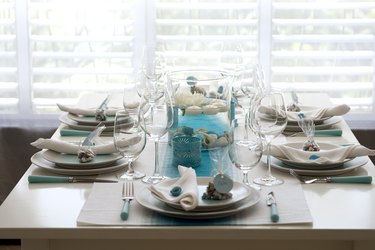Before you can even begin to ascertain a value for your family's heirloom crystal, you first have to establish whether it is really crystal, who made it and how old and rare it is. Although the process of making glass has been around since about 3500 B.C., it wasn't until 1674 that Englishman George Ravenscroft patented the process of adding lead oxides to glass to make crystal.

Is It Real? Determining Genuine Crystal
To determine whether you own authentic leaded crystal glassware, hold it up to a ray of sunlight. When sunlight passes through crystal, it acts as a prism and creates a rainbow.
In another test, you use a spoon to lightly tap just beneath the rim of the glass; if you hear a musical note, it's crystal, but if not, it's just glass. Wet your finger and run it around the rim of the glass: Crystal emits a musical sound; glass does not. While crystal weighs more than glass because of its lead content, it often is much thinner than glass.
Video of the Day
Video of the Day
Find the Mark: Stemware and Glassware Marks
After validating that your stemware is genuine crystal and not glass, the next step in ascertaining its value is to identify the manufacturer. Look on the bottom foot of the stemware, beneath crystal bowls or on the base of a crystal vase for an acid-etched mark, symbol or a sticker that can help you figure out who made the crystal.
If you find a logo or symbol, compare it to other crystal logos online or in crystal identification books. Waterford crystal, for example, often bears the full Waterford name on the bottom of the glass, or it may include an image of a seahorse on a sticker with its name. Other manufacturers often etched the pattern name on the crystal's foot. The American glass company, Fostoria, used a stylized "F" to identify its crystal.
Identify the Pattern
Ready for an art project? Lay a piece of tracing or tissue paper over the bowl or face of the cut crystal and rub a pencil across it to produce a copy of the crystal pattern. You can also take a picture of the crystal, as long as you can clearly see the pattern in the photo; compare the mark to online databases or pictures in books.
Even if you don't know the manufacturer, the pattern can help identify who made the crystal and determine its age. If you find a pattern name acid-etched onto the bottom of the bowl, base or foot, use the name to establish the manufacturer and age of the crystal, which leads to its value.
Put It All Together
Check with crystal replacement sites or companies to establish the value of your crystal. Once you have identified the manufacturer or the pattern, you can check to see what it would cost for a replacement piece, which also lets you know the piece's overall value. The more complete your crystal glassware set and the older and rarer the pattern, the more valuable it is.
Compare your crystal to items being sold at online auction or collector's sites to get an idea of how much it's worth. When you cannot identify the manufacturer or the pattern, check with professional appraisers and collectors who can help you establish its value.